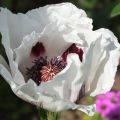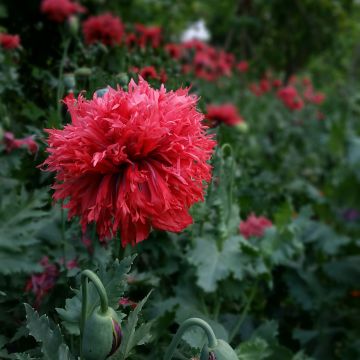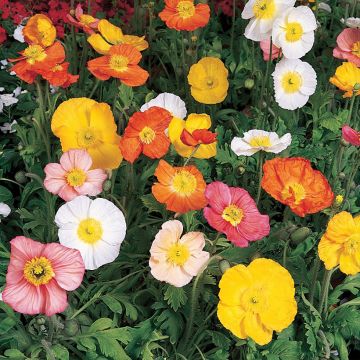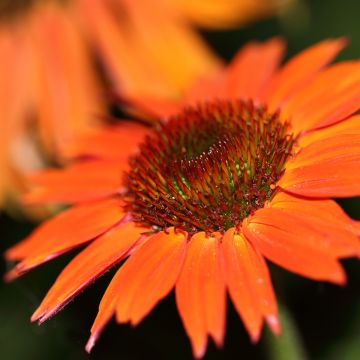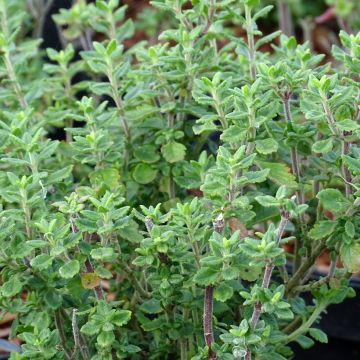Shipping country and language
Your country of residence may be:
Your country of residence is:
For a better user experience on our website, you can select:
Your shipping country:
Andorra
Austria
Belgium
Bulgaria
Canada
Chile
Croatia
Cyprus
Czechia
Denmark
Estonia
Finland
France
Germany
Greece
Hungary
Iceland
Ireland
Italy
Latvia
Lithuania
Luxembourg
Malta
Monaco
Netherlands
Poland
Portugal
Romania
Slovakia
Slovenia
Spain
Sweden
Switzerland
United Kingdom
We only deliver seed and bulb products to your country. If you add other products to your basket, they cannot be shipped.
Language:
French
German
Spanish
English
My Account
Hello
My wish lists
Plantfit
Log in / Register
Existing customer?
New customer?
Create an account to track your orders, access our customer service and, if you wish, make the most of our upcoming offers.


Neck 3 Oriental poppies Victoria Louise, Perry's White, Patty's Plum
Neck 3 Oriental poppies Victoria Louise, Perry's White, Patty's Plum
Papaver orientale Princesse Victoria Louise, Perry's White, Patty's Plum
Pavot de Tournefort
Only 2 out of the 9 plants (I had ordered 3 packs of 3) have taken root... it's all the more of a shame since the flowers are truly magnificent.
Anne-Dominique, 10/09/2022
Order in the next for dispatch today!
Dispatch by letter from €3.90.
Delivery charge from €5.90 Oversize package delivery charge from €6.90.
More information
This item is not available in your country.
Schedule delivery date,
and select date in basket
This plant carries a 12 months recovery warranty
More information
We guarantee the quality of our plants for a full growing cycle, and will replace at our expense any plant that fails to recover under normal climatic and planting conditions.
From €5.90 for pickup delivery and €6.90 for home delivery
Express home delivery from €8.90.
Does this plant fit my garden?
Set up your Plantfit profile →
Collection items (3 plants)
Papaver orientale Prinzessin Victoria Louise - Oriental Poppy
Price per single item: €5.90Find out more
Description
This collection of 3 Oriental poppies blooms from June to July in a range of white, pink, and mauve shades. The large flowers with crinkled silk petals and watercolour tones, highlighted by beautiful dark macules at the base, are perched on stems nearly a meter tall, dominating with their charm an opulent and somewhat disheveled foliage that stands out in flowerbeds. A regular feature in ornamental gardens, the Oriental poppy is a hardy perennial and very easy to grow in all good deep soils, in full sun.
The collection consists of:
- 1 'Princess Victoria Louise' poppy, among the most spectacular: its flowers borne on 90cm (35in) stems are very large, 15 to 20cm (6 to 8in) in diameter, and infinitely bright, in a delightful salmon pink colour, accentuated by almost blue stamens and beautiful black-purple macules at the base of the petals
- 1 'Perry's White' poppy: a large and magnificent variety, 90cm (35in) tall when in bloom, with 10-15cm (4-6in) diameter white flowers shaded with pink, adorned with beautiful almost black central macules, with a heart tinged with pink and wine.
- 1 'Patty's Plum' poppy: 70cm (28in) tall when in bloom, with very beautiful 10cm (4in) diameter flowers in a soft violet rose colour tinged with pale plum and purple-brown macules.
Papaver orientale, also known as Tournefort's poppy, is a herbaceous perennial of the Papaveraceae family, native to Asia. This plant has robust and hairy stems ranging from 70 to 90cm (28 to 35in) in height depending on the varieties. It forms a bushy tuft that thickens over the years. Its large, rough, and hairy leaves have a decorative grey-blue or silvery reflection. The fleshy and deep roots of the Oriental poppy do not tolerate transplantation well, especially in adult plants.
Oriental poppies are very good perennial plants for flowerbeds. Behind their large crinkled petal flowers lies a very robust plant capable of living in poor, stony, and dry soils in summer. After abundant flowering in late spring, the poppy dries up, first the flower stalks, which can be used in dried bouquets, and then the leaves. It completely disappears and goes into dormancy in the heart of summer and re-emerges in autumn to bloom again as soon as the temperatures become milder. It only fears one thing, winter humidity; in heavy soils, the solution is to replace the clayey soil with pure sand in the planting hole.
Oriental poppies are equally at ease in sophisticated flowerbeds as in cottage gardens or countryside compositions. Their hairy and somewhat disheveled foliage forms an opulent and hairy clump that stands out in flowerbeds. Associate them with Artemisias, lavenders, asters, daisies, tall thistles, and light-flowering Nepetas. They also beautifully accompany autumn orpines, whose foliage develops during summer, Damask nigellas, and Cosmos for a summery ambiance in soft colours. In any case, accompany them with perennials as they will fill the space left empty after flowering.
Flowering
Foliage
Plant habit
Botanical data
Papaver
orientale
Princesse Victoria Louise, Perry's White, Patty's Plum
Papaveraceae
Pavot de Tournefort
Cultivar or hybrid
Other Oriental Poppies (Papaver orientale)
Planting and care
Perennial poppies appreciate full sun and can grow in any well-drained garden soil. In heavy and clayey soils, you will plant your poppy in a hole filled with pure sand in a volume equivalent to 3 times that of the pot. Cut the faded flower stems and clean up the old foliage during the summer, but be careful! Wear gloves because the white latex secreted by the plant is toxic and can cause serious burns if it comes into contact with the eyes!
Although they prefer to grow in light and moist soil, Oriental poppies also tolerate dry and gravelly, limestone, as well as heavier, clayey and wet soils, provided they are properly drained and not waterlogged in winter. The plant needs water in autumn and spring, during its entire period of growth and flowering, but can do without it in summer. Another characteristic of this poppy is that its foliage disappears shortly after flowering, but if you take care to cut back the faded inflorescences early, new foliage will grow at the end of summer, filling the gap left for the end of the season.
Planting period
Intended location
Care
- , onOrder confirmed
Reply from on Promesse de fleurs
Summer flowering perennials
Haven't found what you were looking for?
Hardiness is the lowest winter temperature a plant can endure without suffering serious damage or even dying. However, hardiness is affected by location (a sheltered area, such as a patio), protection (winter cover) and soil type (hardiness is improved by well-drained soil).

Photo Sharing Terms & Conditions
In order to encourage gardeners to interact and share their experiences, Promesse de fleurs offers various media enabling content to be uploaded onto its Site - in particular via the ‘Photo sharing’ module.
The User agrees to refrain from:
- Posting any content that is illegal, prejudicial, insulting, racist, inciteful to hatred, revisionist, contrary to public decency, that infringes on privacy or on the privacy rights of third parties, in particular the publicity rights of persons and goods, intellectual property rights, or the right to privacy.
- Submitting content on behalf of a third party;
- Impersonate the identity of a third party and/or publish any personal information about a third party;
In general, the User undertakes to refrain from any unethical behaviour.
All Content (in particular text, comments, files, images, photos, videos, creative works, etc.), which may be subject to property or intellectual property rights, image or other private rights, shall remain the property of the User, subject to the limited rights granted by the terms of the licence granted by Promesse de fleurs as stated below. Users are at liberty to publish or not to publish such Content on the Site, notably via the ‘Photo Sharing’ facility, and accept that this Content shall be made public and freely accessible, notably on the Internet.
Users further acknowledge, undertake to have ,and guarantee that they hold all necessary rights and permissions to publish such material on the Site, in particular with regard to the legislation in force pertaining to any privacy, property, intellectual property, image, or contractual rights, or rights of any other nature. By publishing such Content on the Site, Users acknowledge accepting full liability as publishers of the Content within the meaning of the law, and grant Promesse de fleurs, free of charge, an inclusive, worldwide licence for the said Content for the entire duration of its publication, including all reproduction, representation, up/downloading, displaying, performing, transmission, and storage rights.
Users also grant permission for their name to be linked to the Content and accept that this link may not always be made available.
By engaging in posting material, Users consent to their Content becoming automatically accessible on the Internet, in particular on other sites and/or blogs and/or web pages of the Promesse de fleurs site, including in particular social pages and the Promesse de fleurs catalogue.
Users may secure the removal of entrusted content free of charge by issuing a simple request via our contact form.
The flowering period indicated on our website applies to countries and regions located in USDA zone 8 (France, the United Kingdom, Ireland, the Netherlands, etc.)
It will vary according to where you live:
- In zones 9 to 10 (Italy, Spain, Greece, etc.), flowering will occur about 2 to 4 weeks earlier.
- In zones 6 to 7 (Germany, Poland, Slovenia, and lower mountainous regions), flowering will be delayed by 2 to 3 weeks.
- In zone 5 (Central Europe, Scandinavia), blooming will be delayed by 3 to 5 weeks.
In temperate climates, pruning of spring-flowering shrubs (forsythia, spireas, etc.) should be done just after flowering.
Pruning of summer-flowering shrubs (Indian Lilac, Perovskia, etc.) can be done in winter or spring.
In cold regions as well as with frost-sensitive plants, avoid pruning too early when severe frosts may still occur.
The planting period indicated on our website applies to countries and regions located in USDA zone 8 (France, United Kingdom, Ireland, Netherlands).
It will vary according to where you live:
- In Mediterranean zones (Marseille, Madrid, Milan, etc.), autumn and winter are the best planting periods.
- In continental zones (Strasbourg, Munich, Vienna, etc.), delay planting by 2 to 3 weeks in spring and bring it forward by 2 to 4 weeks in autumn.
- In mountainous regions (the Alps, Pyrenees, Carpathians, etc.), it is best to plant in late spring (May-June) or late summer (August-September).
The harvesting period indicated on our website applies to countries and regions in USDA zone 8 (France, England, Ireland, the Netherlands).
In colder areas (Scandinavia, Poland, Austria...) fruit and vegetable harvests are likely to be delayed by 3-4 weeks.
In warmer areas (Italy, Spain, Greece, etc.), harvesting will probably take place earlier, depending on weather conditions.
The sowing periods indicated on our website apply to countries and regions within USDA Zone 8 (France, UK, Ireland, Netherlands).
In colder areas (Scandinavia, Poland, Austria...), delay any outdoor sowing by 3-4 weeks, or sow under glass.
In warmer climes (Italy, Spain, Greece, etc.), bring outdoor sowing forward by a few weeks.

